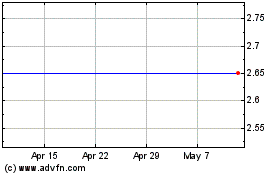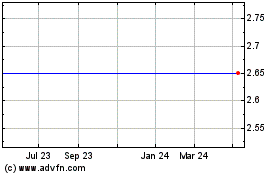TIDMMIO
RNS Number : 5277H
Minco PLC
01 December 2015
Minco Plc
MINCO ANNUAL GENERAL MEETING OF SHAREHOLDERS
--Financial Results for Interim Period September 30, 2015
--Resignation of Director
Dublin, 01 December 2015 - Minco Plc (AIM - "MIO") reports that
at the Annual General Meeting of Shareholders held yesterday in
Dublin all the Resolutions proposed were duly passed with greater
than 99% of the votes cast by proxy in favour of each Resolution.
Details are reported below.
At the Annual Meeting Minco's Chairman, John Kearney, provided
shareholders with an update on the Company's activities.
BUCHANS BASE METAL PROJECTS - Newfoundland Canada
During spring of 2015, Minco completed a drilling programme at
Lucky Strike South at Buchans in central Newfoundland, less than
250 m south of the former Lucky Strike mine where previous operator
Asarco, mined 5.6 million tonnes averaging 18.4% Zn, 8.6% Pb, 1.6%
Cu, 112 g/t Ag & 1.7 g/t Au before closing the Buchans mine in
1984.
Minco's 2015 programme was undertaken to follow up of favourable
results from drilling in 2014 and tested several mineralized
stratigraphic horizons to explore for new high-grade massive
sulphide deposits to depths of 300 metres.
Highlights included the intersection of widespread ore clast
mineralization comprised of massive sulphide fragments hosted by
volcanic breccias within a deeper stratigraphic horizon known as
the "Ore Clast" horizon.
All eight holes designed to test the Ore Clast horizon
intersected mineralized felsic volcanic breccia ranging from 1 to
23 metres in thickness, and containing massive sulphide and
sulphide-rich clasts measuring up to 15 centimetres in diameter.
Intercepts include 0.5 metres averaging 13.32% combined base metals
(i.e., Cu%+Pb%+Zn%) in hole H-15-3493, as well as 1.0 metre
averaging 6.16% combined base metals in hole H-15-3497.
In light of these positive results, Minco expanded its programme
of re-logging historic drill holes to assess potential for new
high-grade discoveries within the Ore Clast horizon, below depths
of previous mining. During 2015, Minco re-logged 156 historic
surface and underground drill holes (13,418 m) southwest of the
former Lucky Strike mine.
This re-logging work focused in on a small high-grade massive
sulphide deposit, known as the West Orebody deposit, with reported
base metal grades similar to Lucky Strike.
The West Orebody deposit was discovered by Asarco in 1940 at a
depth of 300 m and consisted of a cluster of small but high-grade
massive sulphide lenses. The small deposit and was partially mined
during the mid-1940's with an approximate aggregate tonnage of less
than 100,000 tonnes.
While production records and other details are scanty, the West
Orebody deposit has not been a focus of exploration since the 1940s
when the deposit was tested by only short underground holes and a
few widely-spaced surface holes. Previous underground drilling
tended not to test the lateral extents of the ore horizon more than
50 metres beyond the developed orebody.
Re-logging and reinterpretation of archived drill cores by Minco
now suggests this mineralization is located near the intersection
of the Lucky Strike Horizon and the stratigraphically deeper, Ore
Clast Horizon. It is further interpreted that the Ore Clast horizon
is in part a structural feature or rift fault, active during
formation of the Lucky Strike and West Orebodies deposits, and may
have acted as a control structure for the generation of high-grade
massive sulphides.
Minco is planning to drill 2,000 metres in 5 holes in its 2016
programme to further explore the West Orebody deposit and a 400 m
section of the inferred mineralized trend.
MINERAL EXPLORATION AT NORTHERN PENNINES, ENGLAND
Minco's exploration project in the northern Pennines is centered
on a 3.5 by 2.5 kilometre area in the vicinity of the village of
Nenthead, the most prolific area of past production within the
Pennines Orefield which covers a total area of approximately 350
square miles.
Over the period from late 2012 until the first quarter of 2015,
Minco drilled a total of 7,555 metres in 31 holes, of which 17
intersected mineralisation. Twenty five holes were sited to explore
the Great Limestone and six holes tested the deeper basal
succession.
Minco's 2012-2015 drill programme has established a significant
stratiform component to the mineralisation within the Great
Limestone which had not been previously recognised. Intersections
within the Great Limestone have demonstrated the potential for
significant stratiform mineralisation adjacent to historic
workings. The extent of the stratiform mineralisation discovered by
Minco in the Great Limestone to date is encouraging. Similar
mineralisation within the thicker basal succession would be
economically significant.
The intersections of reasonable widths of lead and zinc
mineralization at three different levels in two holes drilled on
the Whitewood-Barneycraig-Williams fault/vein structure in
Northumberland in early 2015, are considered to represent very
positive results that indicate the mineral potential of this large
Whitewood-Barneycraig-Williams fault/vein structure which was
previously demonstrated by historic mining to be mineralized over a
strike length of 3.5 kilometres.
A second phase of drilling is planned for 2016, subject to
conclusion of land access agreements, to further explore the
potential within both the Great Limestone and basal succession with
the primary target for both being the Barneycraig-Whitewood fault
complex.
LEAD-ZINC EXPLORATION, MOATE, COUNTY WESTMEATH, IRELAND
In November 2015, Minco was granted three new Prospecting
Licences in Ireland by the Minister of Communications, Energy and
Natural Resources. The new licences, PLs 1228, 1229 and 3981, at
Moate in County Westmeath, Ireland, are centered on a specific
geological target identified by Minco, with potential for zinc-lead
mineralization of Tynagh Mine type.
Minco's new Moate licences are located along the northwestern
margin of the Irish Midland Orefield on the "Tynagh-Ballinalack
Trend". All but one of the major Irish zinc-lead deposits of the
Irish Midland Orefield lie along the margins of the Orefield. The
Moate target lies mid-way between the former Tynagh Mine, located
50 kilometres to the southwest, and the similar styled Ballinalack
deposit, situated 35 kilometres to the northeast.
The Tynagh Mine operated successfully from 1965 to 1981
producing 9,000,000 tonnes of ore, from both open pit and
underground, at average grades of approximately 7% lead, 5.5% zinc,
0.5% copper and 2.6 ounces of silver per tonne.
Minco's studies of previous drilling have outlined a geological
setting that Minco believes mirrors that at the former Tynagh Mine,
where zinc-lead mineralization was hosted by breccias developed at
the margin between the reef and off-reef limestone facies. The
geology at Moate is also comparable to that at the smaller
Ballinalack deposit.
The Moate area has seen intermittent exploration over the past
fifty years following discovery in 1968 of the Moyvoughly deposit
(125,000 tonnes averaging 8% zinc plus lead) located immediately to
the east of Minco's new licenses. Exploration at Moate in the past,
which includes nine kilometres of diamond drilling, has focused
almost exclusively on the potential for Navan-type mineralization
within the Moyvoughly Beds, initially at shallow depths in the
footwall of the major (300 metre throw) Moyvoughly Fault and later
to depths of 600 metres below surface in the hanging wall. The
potential for reef hosted zinc-lead mineralization of "Tynagh-type"
at Moate has never been explored.
Minco has planned an initial exploration programme consisting of
six inclined drill holes for a total of 1400 metres of
drilling.
METAL PRICES
Metal prices, and zinc and lead prices, in particular, play a
very significant part in the affairs of Minco.
During the third quarter of 2015, zinc prices fell 18% from a
high of US$0.92/lb. to approximately US$0.75/lb. by the end of the
quarter and subsequently declining below US$0.70/lb. while LME and
SHFE zinc warehouse stock levels rose 17% from near 686,000 tonnes
to approximately 803,000 tonnes. Lead prices followed a similar,
but less dramatic, pattern falling from US$0.84/lb. to US$0.76/lb.
in the third quarter while LME lead warehouse stock levels fell
from 220,000 tonnes to 165,000 tonnes.
According to recent research by analysts at Macquarie
Commodities Research, the current situation of rising inventories
and dropping prices is explained by a number of factors. The first
is that the world GDP growth is slowing - recent figures show the
world GDP is at its slowest rate of growth since 2013. The second
factor is that industrial production, which is the key economic
driver of commodity demand, barely grew at all during the second
quarter of 2015. A rally in the US dollar has enabled continuing
profitable production from marginal operations from emerging
markets and China which, in part, led to increasing warehouse
inventories for zinc.
Macquarie sees a number of positives for zinc. They state that a
major chunk of the hidden stocks are now visible and the future
threat level of additional stocks has been diminished. Furthermore,
with the imminent closures of the Lisheen mine in Ireland and
Century mine in Australia.
In November it was announced that China's top zinc smelters plan
to cut refined metal output by 500,000 metric tons next year,
according to a joint statement from 10 producers posted on the
website of Shanghai-based consultancy SMM. The Chinese smelters
statement called for strict control over new capacity and said that
current market prices don't reflect fundamentals and create
operational difficulties.
A similar picture appears for lead as there are only relatively
low warehouse stock levels and output from Chinese mines has fallen
resulting from more stringent environmental controls and the
enforcement of many mine closures.
(MORE TO FOLLOW) Dow Jones Newswires
December 01, 2015 03:56 ET (08:56 GMT)
Minco (LSE:MIO)
Historical Stock Chart
From Mar 2024 to Apr 2024

Minco (LSE:MIO)
Historical Stock Chart
From Apr 2023 to Apr 2024
